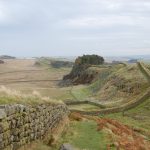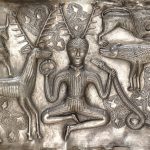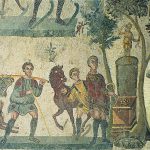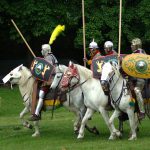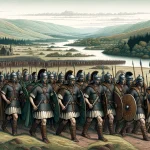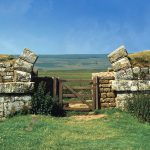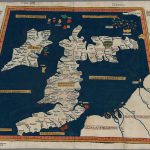Brough-on-Humber (Petuaria) Roman Fort and Civitas
British Civita, Flavian Auxiliary Fort (AD 69–96) and Theatres
Petuaria (or Petuaria Parisorum) was originally a Roman fort situated where the town of Brough in the East Riding of Yorkshire now stands. Petuaria means something like ‘quarter’ or ‘fourth part’, incorporating the archaic Brythonic *petuar, ‘four’ (compare modern Welsh pedwar). It was founded in 70 AD and abandoned in about 125.
The adjacent civitas (civil town), ferry-crossing and (attested) port which grew over and replaced the fort survived until about 370, and was probably the capital of the Celtic tribe called the Parisi. Petuaria marked the southern end of the Roman road known now as Cade’s Road, which ran roughly northwards for a hundred miles to Pons Aelius (modern day Newcastle upon Tyne). The section from Petuaria to Eboracum (York) was also the final section of Ermine Street.
Petuaria became the Civitate for the Parisi. The Archaeological evidence is by no means complete on this site. It is clear that it was a walled town or settlement. Some reports reference it as an early fort and naval base, and that it became a Civitas, the capital of the territory of the Parisi. The archaeological finds do not indicate substantial structures to warrant the Civitas status, and there are a paucity of military finds.
Epigraphic Evidence on Stone
The dedication stone of the Roman theatre was among the most significant finds and is unusual as the only recorded epigraphic mention of a magistrate in Roman Britain. Recording the gift of a proscenium stage to the civic settlement at Petuaria by a man called Marcus Ulpius Januarius, it has been dated to the reign of the Emperor Antoninus Pius and around 140 A.D.
RIB 707 - Dedication to the Divine House of Antoninus Pius
For the honour of the divine house of the Emperor Caesar Titus Aelius Hadrianus Antoninus Augustus Pius, father of his country, consul for the second time, and to the Divinities of the Emperors, Marcus Ulpius Januarius, aedile of the village of Petuaria, presented this [new] stage at his own expense.
DOMVS ▸ DIVI[...]
IMP ▸ CAES ▸ T ▸ AEL ▸ H[...]
ANI ▸ ANT[...]NINI A[...]
P ▸ P COS ▸ I[...]
ET ▸ NVMINIB ▸
Date: if l. 5 is symmetrically spaced, there appears to be enough room for three digits, but not four, after cos. It then dates to A.D. 140-4.For the expansion of Aug. as Aug(ustorum), see note to RIB 152. Addenda from RIB+add. (1995): See Wacher, Excavations at Brough-on-Humber 1958-1961 (1969), esp. 23. Also discussed by Birley, Deities, 23. The width of the text can be calculated from 1-3 and 6-7, whose restoration is certain, from which it appears that in 4 pii was omitted, and that 5 if centred should read p pc cos i[i]. The reading c(ivitas) in the left-hand pelta is better rejected, the ‘C‘ being understood as decoration.
Classical References for Petuaria
The ancient name Petuaria is recorded both in ancient documents and on an inscription uncovered at the site. Across the River Humber (Abus Fluvius) from the minor settlement at Winteringham, other roads led south towards the Roman Colony at Lincoln (Colonia Lindum) also to the south-east through the fourth-century fortified burgi at Caistor and Horncastle, all these sites located in Lincolnshire.
… on the Opportunum Sinus¹ are the Parisi² and the town Petuaria 20*40 56°40 …
- The Opportunum Sinus or the “Gulf of Advantage” was apparently the ancient name for the large spit of land north of the Humber, mostly to the east of a line drawn from Goole on the Humber to Bridlington on the north-east coast.
- The Parisi tribe, then, inhabited the area of North Humberside.
The most useful source of early historical information about Brough on Humber is The Geography of Ptolemy of the early second century. This work provides us with the names of a number of the local geographical features. Aside from the passage which mentions the name of the tribe, the town Petuaria, and the name of the local region of North Humberside quoted above, Ptolemy also names other local geographical features, such as the Ocelus Promontorium in the extreme south-east of the Parisi territory now known as Spurn Head, also the name of the River Humber itself, which was known in Roman times as the Abus Fluvius.
The only other literary reference for the name of this important town on the Humber is the Ravenna Cosmology (R&C#138) of the seventh century. In this work the name Decuaria is listed between the entry for Eburacum (York, East Yorkshire) and the unknown town Devovicia.
The Romano-British name for Brough-on-Humber is thought to stem from the Welsh/Gaelic word petuar, the number four – related to Welsh pedwar – in this instance perhaps meaning ‘the fourth’ or ‘a quarter’, which hints that at least three more towns of the Parisi remain waiting to be discovered.
References for Petvaria [parisorvm]
- The Towns of Roman Britain by John Wacher (2nd Ed., BCA, London, 1995) pp.394-401 & fig.176;
- The Roman Inscriptions of Britain by R.G. Collingwood and R.P. Wright (Oxford 1965).
Map References for Petvaria [parisorvm]
NGRef: SE9326 OSMap: LR106
Roman Roads near Petvaria [parisorvm]
NNW (26) to Bvttercrambe Moor (nr. Stamford Bridge, North Yorkshire) N (31) to Derventio Brigantvm (Malton, North Yorkshire) NW (28) to Ebvracvm NNW (15) to Hayton Humber Ferry: S (2) to Winteringham (Humberside) Iter I: N (17) to Delgovicia (nr. Millington, Humberside)
Sites near Brough-on-Humber (Petuaria) Roman Fort and Civitas
- Winteringham (6 km)
Minor Settlement - Winterton Villa (9 km)
Villa - Hasholme Hall (13 km)
Pottery and Suspected Settlement - Dragonby (Money Field) Settlement (13 km)
Iron Age Settlement and Minor Settlement - Kirmington Roman Fort (22 km)
Claudian Auxiliary Fort (AD 43–54) - Hayton Roman Fort (22 km)
Flavian Auxiliary Fort (AD 69–96) - Hibaldstow Roman Settlement (23 km)
Minor Settlement - Drax (25 km)
Roman-Building - Millington (Delgovicia?) Settlement (27 km)
Minor Settlement and Temple Or Shrine - Caistor Settlement Roman Burg (31 km)
Roman Burg
